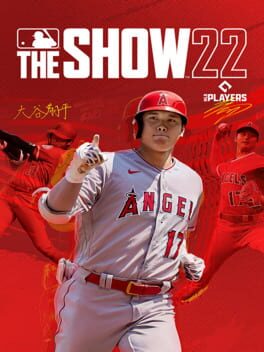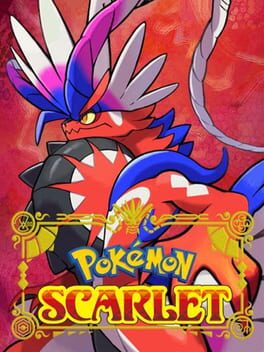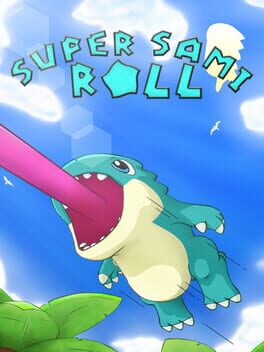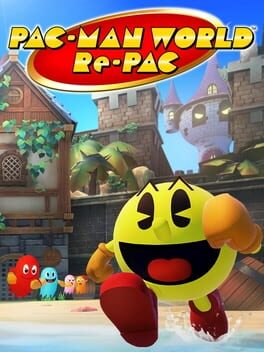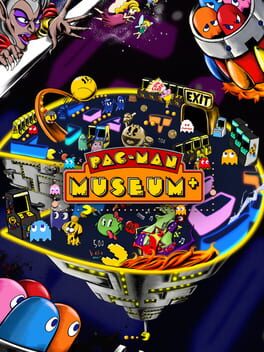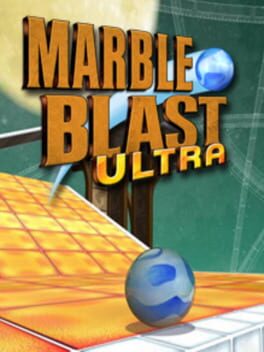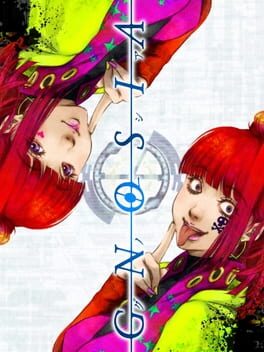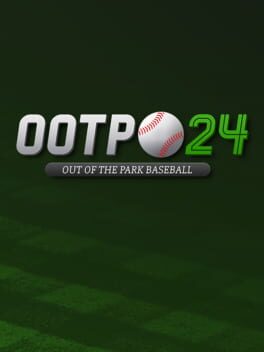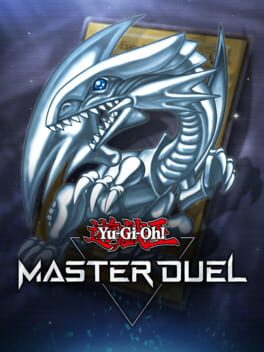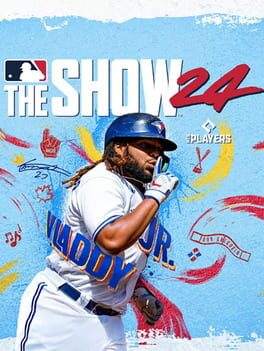BMountain_
Replayed this in July, and the patches have really done a good job improving the experience of this remake. I'd say it's a great way to experience Battle for Bikini Bottom on modern platforms now. I still slightly prefer the visuals and controls of the original release, but the convenience of this version means I usually reach for it now.
2022
(The reason it's only on my journal once is because this is basically all I played this year so it'd be on there way too often.)
Decided to get fully into MLB the Show's Live Service mode this season (Diamond Dynasty) and I'm REALLY happy I did. Not only is it one of the least greedy "card game" modes in a modern sports game (I spent exactly $0 on my all-99 endgame team), it's also seriously addictive - this is the most time I've spent with a yearly baseball game since 2013.
From the Faces of the Franchise featured program in April all the way to the 2022 Finest one, I was invested in upgrading my team and playing the different modes with it.
Both the card marketplace and pack balancing were excellent this year, (although they should find a way to keep live series cards relevant longer into the game's cycle) and the balance of online and offline modes finally reached a point where both kinds of players can be happy. There was new content from the live service team consistently throughout the MLB season.
A big shoutout goes to the early game where I found a bunch of different players to add to the squad that I wouldn't necessarily have predicted I'd use.
In terms of modes, I have to praise them as well: the debut year of Mini Seasons has been fun, Showdown is fun, Conquest is alright, Play vs CPU works well enough, and the online modes are well polished for the most part.
Gameplay was great this season as well; the controls for zone hitting feel spot-on, and the pinpoint pitching is easily the best pitching control scheme San Diego Studio has worked with so far.
The game looks great on Xbox Series S, with most of the action feeling smooth and consistent. Facescans continue to get better and better, and ballparks look almost identical to their real-life versions. The lighting continues to lag behind other modern games, though, and I hope it's improved in MLB 23. The new commentary is a good first step, but it needs refinement in the future.
I'm probably going to play throughout the winter, but I'm done obsessively improving my team. Once I finish the 2022 Postseason Program and add Retro Finest Carlos Delgado to the squad, I'm probably looking at my endgame team.
Road to the Show and Franchise mode are still awful, unfortunately. The lack of improvements made to those modes are why I wasn't big on MLB 19 or MLB 20 and if I hadn't gotten into MLB 22's flagship mode, I'd probably be similarly sour on it.
Ultimately though, Diamond Dynasty is strong enough to recommend MLB 22 to any baseball fan, and I'll probably be pre-ordering MLB 23's MVP or Digital Deluxe editions in Spring 2023. San Francisco Giants infielder Brandon Crawford will be my Opening Day Shortstop.
Here's my endgame squad, excluding any 2022 Postseason cards I don't have yet (2017 Postseason George Springer, Harper, Yordan, maaaaybe Pena) and Delgado.
CF Prime '19 George Springer
SS Retro Finest '17 Francisco Lindor
1B Finest '22 Freddie Freeman
3B Finest '22 Manny Machado
LF Finest '22 Julio Rodriguez
RF Takashi Okazaki Ken Griffey Jr.
2B Finest '22 Xander Bogaerts
C Finest '22 Adley Rutschman
C Finest '22 Will Smith
1B Finest '22 Vladimir Guerrero Jr.
SS Finest '22 Bobby Witt Jr.
RF Milestone '22 Cody Bellinger
SS 2022 Postseason '22 Trea Turner
SP Finest '22 Sandy Alcantara
SP 2022 Postseason '22 Luis Castillo
SP Retro Finest '18 Chris Sale
SP Legends of the Franchise Jered Weaver
SP Finest '22 Tarik Skubal
RP 2022 Postseason '22 Yency Almonte
RP Finest '22 Evan Phillips
RP Finest '20 Devin Williams
RP Retro Finest '77 Bruce Sutter
RP Takashi Okazaki Dennis Eckersley
SU Milestone '16 Zack Britton
SU Finest '22 Felix Bautista
CL Monthly Awards '22 Camilo Doval
Decided to get fully into MLB the Show's Live Service mode this season (Diamond Dynasty) and I'm REALLY happy I did. Not only is it one of the least greedy "card game" modes in a modern sports game (I spent exactly $0 on my all-99 endgame team), it's also seriously addictive - this is the most time I've spent with a yearly baseball game since 2013.
From the Faces of the Franchise featured program in April all the way to the 2022 Finest one, I was invested in upgrading my team and playing the different modes with it.
Both the card marketplace and pack balancing were excellent this year, (although they should find a way to keep live series cards relevant longer into the game's cycle) and the balance of online and offline modes finally reached a point where both kinds of players can be happy. There was new content from the live service team consistently throughout the MLB season.
A big shoutout goes to the early game where I found a bunch of different players to add to the squad that I wouldn't necessarily have predicted I'd use.
In terms of modes, I have to praise them as well: the debut year of Mini Seasons has been fun, Showdown is fun, Conquest is alright, Play vs CPU works well enough, and the online modes are well polished for the most part.
Gameplay was great this season as well; the controls for zone hitting feel spot-on, and the pinpoint pitching is easily the best pitching control scheme San Diego Studio has worked with so far.
The game looks great on Xbox Series S, with most of the action feeling smooth and consistent. Facescans continue to get better and better, and ballparks look almost identical to their real-life versions. The lighting continues to lag behind other modern games, though, and I hope it's improved in MLB 23. The new commentary is a good first step, but it needs refinement in the future.
I'm probably going to play throughout the winter, but I'm done obsessively improving my team. Once I finish the 2022 Postseason Program and add Retro Finest Carlos Delgado to the squad, I'm probably looking at my endgame team.
Road to the Show and Franchise mode are still awful, unfortunately. The lack of improvements made to those modes are why I wasn't big on MLB 19 or MLB 20 and if I hadn't gotten into MLB 22's flagship mode, I'd probably be similarly sour on it.
Ultimately though, Diamond Dynasty is strong enough to recommend MLB 22 to any baseball fan, and I'll probably be pre-ordering MLB 23's MVP or Digital Deluxe editions in Spring 2023. San Francisco Giants infielder Brandon Crawford will be my Opening Day Shortstop.
Here's my endgame squad, excluding any 2022 Postseason cards I don't have yet (2017 Postseason George Springer, Harper, Yordan, maaaaybe Pena) and Delgado.
CF Prime '19 George Springer
SS Retro Finest '17 Francisco Lindor
1B Finest '22 Freddie Freeman
3B Finest '22 Manny Machado
LF Finest '22 Julio Rodriguez
RF Takashi Okazaki Ken Griffey Jr.
2B Finest '22 Xander Bogaerts
C Finest '22 Adley Rutschman
C Finest '22 Will Smith
1B Finest '22 Vladimir Guerrero Jr.
SS Finest '22 Bobby Witt Jr.
RF Milestone '22 Cody Bellinger
SS 2022 Postseason '22 Trea Turner
SP Finest '22 Sandy Alcantara
SP 2022 Postseason '22 Luis Castillo
SP Retro Finest '18 Chris Sale
SP Legends of the Franchise Jered Weaver
SP Finest '22 Tarik Skubal
RP 2022 Postseason '22 Yency Almonte
RP Finest '22 Evan Phillips
RP Finest '20 Devin Williams
RP Retro Finest '77 Bruce Sutter
RP Takashi Okazaki Dennis Eckersley
SU Milestone '16 Zack Britton
SU Finest '22 Felix Bautista
CL Monthly Awards '22 Camilo Doval
2022
I've always considered myself unconvinced that the mainline Pokemon series was best suited for 3D.
Sure, it was very cool as a teenager to see the jump to 3D with 2013’s Pokemon X and Pokemon Y, with the crisp and clean visuals on the Nintendo 3DS showcasing the series’ future for the first time. Given that the system’s predecessor famously struggled with even simple 3D games, it can not be overstated that the next-gen leap to Kalos was impressive and alluring for many, including myself.
As the years progressed however, the honeymoon period with Pokemon’s 3D era definitely faded. 2014’s Omega Ruby and Alpha Sapphire were above average remakes of the series’ third generation, but lacked a true reason to upgrade over the originals, which were only just over ten years old at that point.
2016’s Sun and Moon were another step forward in many respects, but the emphasis on younger players and a more cinematic story that often took control out of your hands for ten minutes or more held back a creative new region and excellent soundtrack. 2019’s Sword and Shield, which I reviewed back in 2020, was a small step forward in many ways for the franchise, but was held back by some questionable game design choices and, in hindsight, an uninteresting story.
Meanwhile, throughout all of that, the visuals had only evolved in small steps since 2013, with many of the Pokemon models only being upscaled to 3D.
A resilient Game Freak then struck gold with 2022’s Pokemon: Legends Arceus. A fantastic open-world style game with an engaging story and fun exploration was aBreath of the Wild breath of fresh air. That said, the adjustments to the battle experiences were major rather than minor (somewhat more reminiscent of Digimon Story: Cyber Sleuth than mainline Pokemon at times), and I found myself struggling to adjust away from a system that I didn’t think needed fixing. It was a truly great game, but I felt a little bit left behind in the hype, and I’d be lying if I said it was truly for me. Perhaps another playthrough will adjust my feelings on it - who knows.
Furthering my mixed feelings on the modern era was the release of 2021’s Brilliant Diamond and Shining Pearl, developed by ILCA, a secondary team hired by The Pokemon Company International to manage the remake while Game Freak was busy with Legends: Arceus and Scarlet/Violet. Shining Pearl, the version I played, was a truly underwhelming experience that highlighted the issues with Sinnoh rather than fixing them. The lack of co-op gameplay in the postgame was disappointing, as was the remixed contest design. The new underground gameplay, which was featured massively in the game’s marketing, featured some interesting ideas but removed all motivation to make secret bases - the best underground feature from the original games. Meanwhile, much of the game looked worse than the DS originals, with underwhelming textures and flat colours. The soundtrack was extremely flat-sounding and uninspired, and the DS Sounds option thrown into the game was locked to postgame - no matter, as it sounds tinny and thin compared to the game’s OST on iTunes.
So you may forgive me, then, when Pokemon Scarlet and Violet were released mere months after Legends: Arceus, I was less so cautiously optimistic and more so cautious - truthfully, maybe cautiously pessimistic. Attention was given to the game’s uninspired visuals and horrendous framerate, both of which turned me off so much in my first session with the game that I put it back down for almost half a year.
When a Pokemon mood comes for you though, you want to play Pokemon - and to borrow a phrase I should’ve remembered from my Sword and Shield review - I should’ve remembered that “Game Freak is pretty good at this whole video game thing.”
Let’s start with the criticisms I have, because as the star rating suggests, it’s a shorter list. The game is not pretty, and the game is not stable.
The overworlds are pretty generic and bland feeling, with very little of the personality from previous routes returning. You won’t find nugget bridge, you won’t find biker roads, and you won’t find victory road. The winter area is a winter area. The desert area is a desert area. Nothing is straight-up bad about their design, and it’s easy to get immersed in them, but they’re still a step back from the bright, colourful routes in Sword and Shield or Sun and Moon. Pokemon appear in the overworld, and they mostly act natural, but sometimes they get stuck or disappear based on the camera angle. There’s an annoying amount of pop-in.
The towns are also pretty forgettable, with the exceptions being the main school town of Mezagoza and the big towns of Cascarrafa and Levincia. Towards the start of the game, you’re told that Paldea has three cities, and those are the areas with the most detail and care. Nothing’s as memorable as the gorgeous Ballonlea from last generation.
The framerate and performance stinks. While Sword and Shield mostly ran well aside from the wild area, Scarlet and Violet really struggle in every way performance-wise. It’s never consistent, dips frequently, and it genuinely takes time to get your eyes used to it.
Those sound like big asterisks for a five-star rating - and honestly, they are. But more honestly? It’s hard to dock points off the star rating when none of those issues really matter to me anymore.
Scarlet and Violet are easy to get lost in. They’re incredibly immersive, and they are easily, easily the closest to my childhood visions of a 3D Pokemon world that Game Freak has ever achieved. The Pokemon feel alive, and even with all the negatives I’ve stated about the world design, it feels genuine and authentic as a region. Exploration on Koraidon, my ride Pokemon, was exceptionally natural-feeling and addicting. Whether you’re battling traditionally or using the “let’s go” feature to auto-battle, it’s rewarding to relax and level up your Pokemon.
The game features two large campaigns and a small campaign, a surprisingly meaty amount of content compared to the rest of the series’ 3D era. The first one is a traditional gym quest, adjusted to work in an open-world game. Dynamic level-scaling would’ve been nice so you can truly go anywhere in any order, but it’s ultimately not necessary and the game’s map does guide you on a general order to complete the gyms in. The gym challenges return in a similar fashion to Sword and Shield’s, but feel more thought out and interesting.
The second campaign features the game’s antagonistic Team Star, and it’s the game’s absolute highlight campaign. It’s the most challenging, and it genuinely could have been the main part of the game without me complaining. The third campaign, featuring the “Titan Pokemon,” is more linear and the least challenging, especially if you completed it as the final one as I did - it also unlocks upgrades for your ride Pokemon. I recommend completing it last, as limiting your options to travel fast within the region helps you appreciate it more.
The story of the game is, without hesitation, my favourite Pokemon story to date. The writers mix in humour with genuinely heartfelt moments, and the characters are extremely memorable and well-designed. Following completion of the three main campaigns, the final chapter unlocks and makes for the best hour of Pokemon gameplay to date - avoid spoilers for it if you can. It’s all genuinely really special stuff.
Game Freak has also listened to feedback on lengthy tutorials and hands-off story elements - thankfully, both are kept to a relative minimum here.
Training and maintaining your Pokemon team is seamless in this game, and the best way yet to build your trainer’s collection. While not every Pokemon is featured in Paldea, the compatibility with Pokemon Home should allow most to build their teams in a way that suits them. Mints, hyper training, and breeding return as options for big fans of the series to create competitive teams, and they’re all welcome choices.
Difficulty-wise, I found the game fairly unchallenging. The Team Star bosses are the highlight of the game difficulty-wise, and they all give a good battle. I found the gyms somewhat less challenging than an average Pokemon playthrough, and I found the Titan Pokemon very weak - although I did leave them until last. The Titan Pokemon were most in need of dynamic level scaling. The Elite Four, returning in full for the first time since X and Y, were somewhat more difficult than average, but the Paldean Top Champion was far from the toughest in the series.
Your rival, Nemona, gives a series of challenging battles through the game. Everything feels more fun and engaging than the previous generation, but a little less tough. The story and exploration makes up for this, but you’ll probably want to look online for the biggest challenge. The postgame tournaments return from Galar, but are better for training up new team members than they are for returning with your champion team.
For the more casual audience, the individual Pokemon are the highlight of the game visually, as the majority of them have been given new textures and animations. They look really great, although it’s still fairly unflattering in general compared to Sword and Shield.
Some additional notes: Trainer customization returns, although that too takes a step back compared to the previous generation...The new era of Pokemon designs is as sharp as expected, although the roster feels a little small...The soundtrack is one of the stronger ones in Pokemon, with some great overworld tracks and battle songs. It’s not as great as Hoenn’s or Alola’s tunes, but it’s toward the upper tier of Pokemon soundtracks.
When Pokemon Sword and Shield released, a lot of expectation was placed on it to be the Pokemon version of The Legend of Zelda: Breath of the Wild or Super Mario Odyssey. Although a fairly good game, it decidedly was not.
Pokemon Scarlet and Violet are a lot closer - a game that features the best of the series in many ways, from story to exploration to immersiveness. Casual fans should enjoy the story a lot and find a team to enjoy. Big fans will really love the ability to build a competitive team and immerse themselves in the world - and they most likely won’t dislike the story - for the first time in a while.
The story and the addictive nature of the gameplay has thoroughly impressed me - Game Freak’s definitely still the team to put in charge of this franchise. In addition, this is the first generation where I feel that the switch to 3D is the right thing for the franchise.
Well done, team.
Sure, it was very cool as a teenager to see the jump to 3D with 2013’s Pokemon X and Pokemon Y, with the crisp and clean visuals on the Nintendo 3DS showcasing the series’ future for the first time. Given that the system’s predecessor famously struggled with even simple 3D games, it can not be overstated that the next-gen leap to Kalos was impressive and alluring for many, including myself.
As the years progressed however, the honeymoon period with Pokemon’s 3D era definitely faded. 2014’s Omega Ruby and Alpha Sapphire were above average remakes of the series’ third generation, but lacked a true reason to upgrade over the originals, which were only just over ten years old at that point.
2016’s Sun and Moon were another step forward in many respects, but the emphasis on younger players and a more cinematic story that often took control out of your hands for ten minutes or more held back a creative new region and excellent soundtrack. 2019’s Sword and Shield, which I reviewed back in 2020, was a small step forward in many ways for the franchise, but was held back by some questionable game design choices and, in hindsight, an uninteresting story.
Meanwhile, throughout all of that, the visuals had only evolved in small steps since 2013, with many of the Pokemon models only being upscaled to 3D.
A resilient Game Freak then struck gold with 2022’s Pokemon: Legends Arceus. A fantastic open-world style game with an engaging story and fun exploration was a
Furthering my mixed feelings on the modern era was the release of 2021’s Brilliant Diamond and Shining Pearl, developed by ILCA, a secondary team hired by The Pokemon Company International to manage the remake while Game Freak was busy with Legends: Arceus and Scarlet/Violet. Shining Pearl, the version I played, was a truly underwhelming experience that highlighted the issues with Sinnoh rather than fixing them. The lack of co-op gameplay in the postgame was disappointing, as was the remixed contest design. The new underground gameplay, which was featured massively in the game’s marketing, featured some interesting ideas but removed all motivation to make secret bases - the best underground feature from the original games. Meanwhile, much of the game looked worse than the DS originals, with underwhelming textures and flat colours. The soundtrack was extremely flat-sounding and uninspired, and the DS Sounds option thrown into the game was locked to postgame - no matter, as it sounds tinny and thin compared to the game’s OST on iTunes.
So you may forgive me, then, when Pokemon Scarlet and Violet were released mere months after Legends: Arceus, I was less so cautiously optimistic and more so cautious - truthfully, maybe cautiously pessimistic. Attention was given to the game’s uninspired visuals and horrendous framerate, both of which turned me off so much in my first session with the game that I put it back down for almost half a year.
When a Pokemon mood comes for you though, you want to play Pokemon - and to borrow a phrase I should’ve remembered from my Sword and Shield review - I should’ve remembered that “Game Freak is pretty good at this whole video game thing.”
Let’s start with the criticisms I have, because as the star rating suggests, it’s a shorter list. The game is not pretty, and the game is not stable.
The overworlds are pretty generic and bland feeling, with very little of the personality from previous routes returning. You won’t find nugget bridge, you won’t find biker roads, and you won’t find victory road. The winter area is a winter area. The desert area is a desert area. Nothing is straight-up bad about their design, and it’s easy to get immersed in them, but they’re still a step back from the bright, colourful routes in Sword and Shield or Sun and Moon. Pokemon appear in the overworld, and they mostly act natural, but sometimes they get stuck or disappear based on the camera angle. There’s an annoying amount of pop-in.
The towns are also pretty forgettable, with the exceptions being the main school town of Mezagoza and the big towns of Cascarrafa and Levincia. Towards the start of the game, you’re told that Paldea has three cities, and those are the areas with the most detail and care. Nothing’s as memorable as the gorgeous Ballonlea from last generation.
The framerate and performance stinks. While Sword and Shield mostly ran well aside from the wild area, Scarlet and Violet really struggle in every way performance-wise. It’s never consistent, dips frequently, and it genuinely takes time to get your eyes used to it.
Those sound like big asterisks for a five-star rating - and honestly, they are. But more honestly? It’s hard to dock points off the star rating when none of those issues really matter to me anymore.
Scarlet and Violet are easy to get lost in. They’re incredibly immersive, and they are easily, easily the closest to my childhood visions of a 3D Pokemon world that Game Freak has ever achieved. The Pokemon feel alive, and even with all the negatives I’ve stated about the world design, it feels genuine and authentic as a region. Exploration on Koraidon, my ride Pokemon, was exceptionally natural-feeling and addicting. Whether you’re battling traditionally or using the “let’s go” feature to auto-battle, it’s rewarding to relax and level up your Pokemon.
The game features two large campaigns and a small campaign, a surprisingly meaty amount of content compared to the rest of the series’ 3D era. The first one is a traditional gym quest, adjusted to work in an open-world game. Dynamic level-scaling would’ve been nice so you can truly go anywhere in any order, but it’s ultimately not necessary and the game’s map does guide you on a general order to complete the gyms in. The gym challenges return in a similar fashion to Sword and Shield’s, but feel more thought out and interesting.
The second campaign features the game’s antagonistic Team Star, and it’s the game’s absolute highlight campaign. It’s the most challenging, and it genuinely could have been the main part of the game without me complaining. The third campaign, featuring the “Titan Pokemon,” is more linear and the least challenging, especially if you completed it as the final one as I did - it also unlocks upgrades for your ride Pokemon. I recommend completing it last, as limiting your options to travel fast within the region helps you appreciate it more.
The story of the game is, without hesitation, my favourite Pokemon story to date. The writers mix in humour with genuinely heartfelt moments, and the characters are extremely memorable and well-designed. Following completion of the three main campaigns, the final chapter unlocks and makes for the best hour of Pokemon gameplay to date - avoid spoilers for it if you can. It’s all genuinely really special stuff.
Game Freak has also listened to feedback on lengthy tutorials and hands-off story elements - thankfully, both are kept to a relative minimum here.
Training and maintaining your Pokemon team is seamless in this game, and the best way yet to build your trainer’s collection. While not every Pokemon is featured in Paldea, the compatibility with Pokemon Home should allow most to build their teams in a way that suits them. Mints, hyper training, and breeding return as options for big fans of the series to create competitive teams, and they’re all welcome choices.
Difficulty-wise, I found the game fairly unchallenging. The Team Star bosses are the highlight of the game difficulty-wise, and they all give a good battle. I found the gyms somewhat less challenging than an average Pokemon playthrough, and I found the Titan Pokemon very weak - although I did leave them until last. The Titan Pokemon were most in need of dynamic level scaling. The Elite Four, returning in full for the first time since X and Y, were somewhat more difficult than average, but the Paldean Top Champion was far from the toughest in the series.
Your rival, Nemona, gives a series of challenging battles through the game. Everything feels more fun and engaging than the previous generation, but a little less tough. The story and exploration makes up for this, but you’ll probably want to look online for the biggest challenge. The postgame tournaments return from Galar, but are better for training up new team members than they are for returning with your champion team.
For the more casual audience, the individual Pokemon are the highlight of the game visually, as the majority of them have been given new textures and animations. They look really great, although it’s still fairly unflattering in general compared to Sword and Shield.
Some additional notes: Trainer customization returns, although that too takes a step back compared to the previous generation...The new era of Pokemon designs is as sharp as expected, although the roster feels a little small...The soundtrack is one of the stronger ones in Pokemon, with some great overworld tracks and battle songs. It’s not as great as Hoenn’s or Alola’s tunes, but it’s toward the upper tier of Pokemon soundtracks.
When Pokemon Sword and Shield released, a lot of expectation was placed on it to be the Pokemon version of The Legend of Zelda: Breath of the Wild or Super Mario Odyssey. Although a fairly good game, it decidedly was not.
Pokemon Scarlet and Violet are a lot closer - a game that features the best of the series in many ways, from story to exploration to immersiveness. Casual fans should enjoy the story a lot and find a team to enjoy. Big fans will really love the ability to build a competitive team and immerse themselves in the world - and they most likely won’t dislike the story - for the first time in a while.
The story and the addictive nature of the gameplay has thoroughly impressed me - Game Freak’s definitely still the team to put in charge of this franchise. In addition, this is the first generation where I feel that the switch to 3D is the right thing for the franchise.
Well done, team.
2021
2022
Yeah this is one of the easiest 5 grades I’ve ever given. This game is genuinely incredible. Just a fantastic experience all around if you can overlook the framerate issues, which are bad but nowhere near game-breaking. An absolute triumph for the series in easily their best mainline game since the transition to 3D.
2022
2022
Meh. It's not a bad remake, and it's nice that it exists, because it's a game that's worth playing. It's never been my favourite of the trilogy though. Bonus points for updating the music post-launch (a change from compressed garbage to mostly pretty good sound!), but they updated that well after I finished the game. They apparently also fixed some of the depth perception, which I found was a big issue in the second half of the game. It's a solid platformer that's most unspectacular in 2022, even if it's still reasonably enjoyable.
2022
A mostly faithful port with some enhancements to Episode One and Episode Two, though I feel some of the facial motion capture doesn't hold up as well in this version as it does in the original. Episode Three is a technical mess, with visual bugs appearing more often than not. Just play the original.
2006
2019
THIS IS A REVIEW I ORIGINALLY POSTED IN NOVEMBER 2019 ON MY OLD WEBSITE.
The debut of The Legend of Zelda: Breath of the Wild in 2017 opened the door for Nintendo to walk into a more modern stage. It gave the company an opportunity to reimagine or retool their classic IPs in a new way for a different audience beyond the diehard fans.
Breath of the Wild was Zelda’s turn, and it was a smashing success.
Mario fans received Super Mario Odyssey, a modern collectathon that managed to reinvent the formula in a unique way — all while feeling like a throwback to Mario’s debut on the Nintendo 64. Titles like Super Mario Maker 2, Luigi’s Mansion 3, and Splatoon 2 all brought modern touches to ideas that were launched prior to the current generation.
Pokémon, though, was a different story. While it was a charming nostalgic throwback with interesting ideas, Pokémon: Let’s Go Eevee and Let’s Go Pikachu weren’t the same game-changing entries that Odyssey and Breath of the Wild represented for their respective series.
Simply put, Game Freak played it safe.
Now, though, among the cries of “Dexit” and the exposure of 3DS models being used for new entries, the Japanese studio couldn’t afford to simply phone in another entry.
It’s a good thing that they didn’t, too.
Perhaps the worry was overblown. Perhaps, through the controversy and the cursing on social media, everyone should have remembered that Game Freak is pretty good at this whole video game thing.
Pokémon Shield is a game that plays to the strengths of the series, while also abandoning most of the missteps that have plagues the recent entries.
Gone is the requirement to use a single joycon while the game is docked to a television. Gone are many of the cutscenes that made Pokémon: Ultra Sun and Ultra Moon such a chore to replay. Gone is the over-reliance on legendary Pokémon.
In a way, Game Freak has brought the series back to its roots after a Gen 7 that was focused on reinventing a formula that wasn’t especially broken.
That said, the studio has kept ideas that worked from past entries as well. Borrowed from Let’s Go, the PC is now portable, and may be accessed at any time. Borrowed from Sun and Moon, the type matchups are now on-screen when you’re opposing a Pokémon you’ve already caught. The new Pokémon Camp feature borrows from Pokémon-Amie from X and Y.
Most importantly to the formula, Pokémon still walk in the overworld for the most part, removing the random encounters. It’s a godsend for those who wish to complete the Pokédex without it being a tedious chore like it was in the 3DS entries.
They’ve also made it more convenient to switch the movesets for your party members, rename them, and gain experience from in-game “jobs,” all inside the Pokémon Centre. This is the most streamlined game in the series.
The battles have also seen an improvement with the jump to a console. Unlike the later 3DS entries (or the GameCube-era console games), they’re speedy, with damage being applied as quickly as it was in X and Y. There’s no more lag to worry about, thanks to the excellent optimization on the Switch. The Max Raid battles have seen clear inspiration from the Persona series, especially visually.
“Dynamaxing” is also an interesting addition to the game’s strategy, rather than a gimmick like “Mega Evolution” or “Z-Moves.” In fact, this is the strongest game in the series when it comes to strategy. If you’re playing at a normal pace, gym battles and important narrative battles feel important and difficult, while also never spiking in difficulty. It’s really a brilliant job they’ve done with the foes, and the gym leaders tend to use potions and factor in type matchups like never before. It’s a lot like going on Showdown and facing a real human.
Speaking of the story and narrative elements, it’s one of the stronger ones in the series, and is around 24 hours long. Gym battles are now much more visually similar to how they’ve been portrayed in the anime, and the NPCs feel real and have a lot of thought put behind them. The “evil team” cliche is mostly absent in favour of more three-dimensional characters, and it’s easy to get invested in the story of your rivals.
It’s not all roses, though. While it doesn’t get to the irritating levels of the 3DS entries, your main rival does pop into the story far too often than one feels he should, and it actually breaks the pace of the game a little too much. Cutscenes aren’t a huge problem in the game, and late-game ones work wonderfully, but Pokémon hasn’t quite perfected their early-game cutscene-to-gameplay ratio quite yet.
That said, Game Freak’s design-team brought their top game to this entry and it’s wonderful as a result. The towns are varied and unique, and they maintain the style of the series while adapting wonderfully to a main console. The new Pokémon designs are a delight, and a consistent strong point of the series even in its lower quality games. The designs for the characters are on point as well, and character customization’s welcome return doesn’t disappoint.
Let’s Go looked fine from a design standpoint, but it was very familiar. Shield excels.
Unfortunately, it doesn’t excel everywhere visually. In an effort to keep things smooth and consistent visually, the draw distance is very poor for a modern game on a console that ran Super Mario Odyssey flawlessly. One one hand, that’s a bit apples-and oranges, but on the other, Shield should probably be looking a little bit more polished than it does at times.
Animations are well done, and better then you might believe looking at the trailers and posts from irritated fans, but there’s still the clunky one here or there. They’re a solid step up from the 3DS game animations overall, even if they still lack the personality of the ones from the older console entries or even the DS-era sprites.
The wild area is also slightly disappointing. Pokémon of any level can spawn there, and it’s fine overall, but it feels slightly generic as a whole and underutilized in the story. The addition of a fully controllable camera is nice, though, and this could eventually be the starting blueprint of a whole game like this.
On a brighter note, the soundtrack is genuinely excellent. Unlike the nostalgia-based tunes from Let’s Go, this OST feels fresh and exciting. It’s one that absolutely deserves attention on YouTube.
The Dexit-focused Pokémon fans will argue that Sword and Shield needed more time to bake, so that all the cut Pokémon could make it into the first real entry on Nintendo Switch. Perhaps that’s true. But Game Freak has done a lot right with this one, and it’d be a shame to ignore that because of frustration toward one element of the game.
It’s not Pokémon’s Breath of the Wild. But with a good story, excellent AI/difficulty balancing, great music, and the best battles of the series, Pokémon Shield (or Sword) is a lot of fun and doesn’t disappoint.
The debut of The Legend of Zelda: Breath of the Wild in 2017 opened the door for Nintendo to walk into a more modern stage. It gave the company an opportunity to reimagine or retool their classic IPs in a new way for a different audience beyond the diehard fans.
Breath of the Wild was Zelda’s turn, and it was a smashing success.
Mario fans received Super Mario Odyssey, a modern collectathon that managed to reinvent the formula in a unique way — all while feeling like a throwback to Mario’s debut on the Nintendo 64. Titles like Super Mario Maker 2, Luigi’s Mansion 3, and Splatoon 2 all brought modern touches to ideas that were launched prior to the current generation.
Pokémon, though, was a different story. While it was a charming nostalgic throwback with interesting ideas, Pokémon: Let’s Go Eevee and Let’s Go Pikachu weren’t the same game-changing entries that Odyssey and Breath of the Wild represented for their respective series.
Simply put, Game Freak played it safe.
Now, though, among the cries of “Dexit” and the exposure of 3DS models being used for new entries, the Japanese studio couldn’t afford to simply phone in another entry.
It’s a good thing that they didn’t, too.
Perhaps the worry was overblown. Perhaps, through the controversy and the cursing on social media, everyone should have remembered that Game Freak is pretty good at this whole video game thing.
Pokémon Shield is a game that plays to the strengths of the series, while also abandoning most of the missteps that have plagues the recent entries.
Gone is the requirement to use a single joycon while the game is docked to a television. Gone are many of the cutscenes that made Pokémon: Ultra Sun and Ultra Moon such a chore to replay. Gone is the over-reliance on legendary Pokémon.
In a way, Game Freak has brought the series back to its roots after a Gen 7 that was focused on reinventing a formula that wasn’t especially broken.
That said, the studio has kept ideas that worked from past entries as well. Borrowed from Let’s Go, the PC is now portable, and may be accessed at any time. Borrowed from Sun and Moon, the type matchups are now on-screen when you’re opposing a Pokémon you’ve already caught. The new Pokémon Camp feature borrows from Pokémon-Amie from X and Y.
Most importantly to the formula, Pokémon still walk in the overworld for the most part, removing the random encounters. It’s a godsend for those who wish to complete the Pokédex without it being a tedious chore like it was in the 3DS entries.
They’ve also made it more convenient to switch the movesets for your party members, rename them, and gain experience from in-game “jobs,” all inside the Pokémon Centre. This is the most streamlined game in the series.
The battles have also seen an improvement with the jump to a console. Unlike the later 3DS entries (or the GameCube-era console games), they’re speedy, with damage being applied as quickly as it was in X and Y. There’s no more lag to worry about, thanks to the excellent optimization on the Switch. The Max Raid battles have seen clear inspiration from the Persona series, especially visually.
“Dynamaxing” is also an interesting addition to the game’s strategy, rather than a gimmick like “Mega Evolution” or “Z-Moves.” In fact, this is the strongest game in the series when it comes to strategy. If you’re playing at a normal pace, gym battles and important narrative battles feel important and difficult, while also never spiking in difficulty. It’s really a brilliant job they’ve done with the foes, and the gym leaders tend to use potions and factor in type matchups like never before. It’s a lot like going on Showdown and facing a real human.
Speaking of the story and narrative elements, it’s one of the stronger ones in the series, and is around 24 hours long. Gym battles are now much more visually similar to how they’ve been portrayed in the anime, and the NPCs feel real and have a lot of thought put behind them. The “evil team” cliche is mostly absent in favour of more three-dimensional characters, and it’s easy to get invested in the story of your rivals.
It’s not all roses, though. While it doesn’t get to the irritating levels of the 3DS entries, your main rival does pop into the story far too often than one feels he should, and it actually breaks the pace of the game a little too much. Cutscenes aren’t a huge problem in the game, and late-game ones work wonderfully, but Pokémon hasn’t quite perfected their early-game cutscene-to-gameplay ratio quite yet.
That said, Game Freak’s design-team brought their top game to this entry and it’s wonderful as a result. The towns are varied and unique, and they maintain the style of the series while adapting wonderfully to a main console. The new Pokémon designs are a delight, and a consistent strong point of the series even in its lower quality games. The designs for the characters are on point as well, and character customization’s welcome return doesn’t disappoint.
Let’s Go looked fine from a design standpoint, but it was very familiar. Shield excels.
Unfortunately, it doesn’t excel everywhere visually. In an effort to keep things smooth and consistent visually, the draw distance is very poor for a modern game on a console that ran Super Mario Odyssey flawlessly. One one hand, that’s a bit apples-and oranges, but on the other, Shield should probably be looking a little bit more polished than it does at times.
Animations are well done, and better then you might believe looking at the trailers and posts from irritated fans, but there’s still the clunky one here or there. They’re a solid step up from the 3DS game animations overall, even if they still lack the personality of the ones from the older console entries or even the DS-era sprites.
The wild area is also slightly disappointing. Pokémon of any level can spawn there, and it’s fine overall, but it feels slightly generic as a whole and underutilized in the story. The addition of a fully controllable camera is nice, though, and this could eventually be the starting blueprint of a whole game like this.
On a brighter note, the soundtrack is genuinely excellent. Unlike the nostalgia-based tunes from Let’s Go, this OST feels fresh and exciting. It’s one that absolutely deserves attention on YouTube.
The Dexit-focused Pokémon fans will argue that Sword and Shield needed more time to bake, so that all the cut Pokémon could make it into the first real entry on Nintendo Switch. Perhaps that’s true. But Game Freak has done a lot right with this one, and it’d be a shame to ignore that because of frustration toward one element of the game.
It’s not Pokémon’s Breath of the Wild. But with a good story, excellent AI/difficulty balancing, great music, and the best battles of the series, Pokémon Shield (or Sword) is a lot of fun and doesn’t disappoint.
2019
Yu-Gi-Oh gets extremely complicated, but this is a fantastic way to play it online. It's reasonably generous with the free-to-play path, and it's a faithful, immersive way to play the TCG itself. Yu-Gi-Oh took what worked from the online TCGs and made itself a really good online version of the game.
2024

